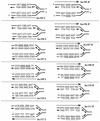Lack of strand bias in UV-induced mutagenesis in Escherichia coli
- PMID: 12142415
- PMCID: PMC135265
- DOI: 10.1128/JB.184.16.4449-4454.2002
Lack of strand bias in UV-induced mutagenesis in Escherichia coli
Abstract
We have investigated whether UV-induced mutations are created with equal efficiency on the leading and lagging strands of DNA replication. We employed an assay system that permits measurement of mutagenesis in the lacZ gene in pairs of near-identical strains. Within each pair, the strains differ only in the orientation of the lacZ gene with respect to the origin of DNA replication. Depending on this orientation, any lacZ target sequence will be replicated in one orientation as a leading strand and as a lagging strand in the other orientation. In contrast to previous results obtained for mutations resulting from spontaneous replication errors or mutations resulting from the spontaneous SOS mutator effect, measurements of UV-induced mutagenesis in uvrA strains fail to show significant differences between the two target orientations. These data suggest that SOS-mediated mutagenic translesion synthesis on the Escherichia coli chromosome may occur with equal or similar probability on leading and lagging strands.
Figures


Similar articles
-
SOS mutator activity: unequal mutagenesis on leading and lagging strands.Proc Natl Acad Sci U S A. 2000 Nov 7;97(23):12678-83. doi: 10.1073/pnas.220424697. Proc Natl Acad Sci U S A. 2000. PMID: 11050167 Free PMC article.
-
Asymmetry of frameshift mutagenesis during leading and lagging-strand replication in Escherichia coli.Mutat Res. 2002 Apr 25;501(1-2):129-36. doi: 10.1016/s0027-5107(02)00020-9. Mutat Res. 2002. PMID: 11934444
-
Unequal fidelity of leading strand and lagging strand DNA replication on the Escherichia coli chromosome.Proc Natl Acad Sci U S A. 1998 Aug 18;95(17):10020-5. doi: 10.1073/pnas.95.17.10020. Proc Natl Acad Sci U S A. 1998. PMID: 9707593 Free PMC article.
-
SOS and Mayday: multiple inducible mutagenic pathways in Escherichia coli.Mol Microbiol. 1998 Dec;30(5):905-10. doi: 10.1046/j.1365-2958.1998.01120.x. Mol Microbiol. 1998. PMID: 9988468 Review.
-
Current understanding of UV-induced base pair substitution mutation in E. coli with particular reference to the DNA polymerase III complex.Mutat Res. 1987 Dec;181(2):219-26. doi: 10.1016/0027-5107(87)90099-6. Mutat Res. 1987. PMID: 3317025 Review.
Cited by
-
Bacteriocin-mediated inhibition of some common pathogens by wild and mutant Lactobacillus species and in vitro amplification of bacteriocin encoding genes.ADMET DMPK. 2022 Feb 14;10(1):75-87. doi: 10.5599/admet.1053. eCollection 2022. ADMET DMPK. 2022. PMID: 35360671 Free PMC article.
-
Mutation frequency and spectrum of mutations vary at different chromosomal positions of Pseudomonas putida.PLoS One. 2012;7(10):e48511. doi: 10.1371/journal.pone.0048511. Epub 2012 Oct 31. PLoS One. 2012. PMID: 23119042 Free PMC article.
-
Spatial and Temporal Control of Evolution through Replication-Transcription Conflicts.Trends Microbiol. 2017 Jul;25(7):515-521. doi: 10.1016/j.tim.2017.01.008. Epub 2017 Feb 16. Trends Microbiol. 2017. PMID: 28216294 Free PMC article.
-
Role of Escherichia coli DNA polymerase I in chromosomal DNA replication fidelity.Mol Microbiol. 2009 Dec;74(5):1114-27. doi: 10.1111/j.1365-2958.2009.06921.x. Epub 2009 Oct 19. Mol Microbiol. 2009. PMID: 19843230 Free PMC article.
-
Escherichia coli frameshift mutation rate depends on the chromosomal context but not on the GATC content near the mutation site.PLoS One. 2012;7(3):e33701. doi: 10.1371/journal.pone.0033701. Epub 2012 Mar 16. PLoS One. 2012. PMID: 22438985 Free PMC article.
References
Publication types
MeSH terms
LinkOut - more resources
Full Text Sources

